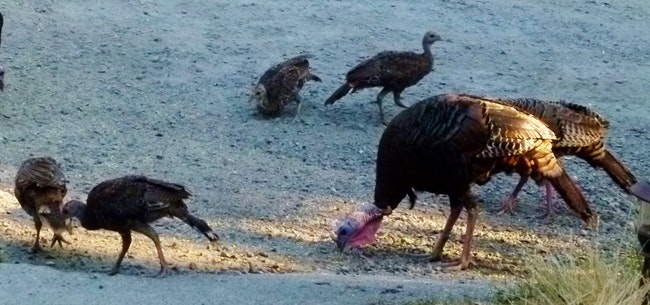
Wild turkeys in the Salem area (Courtesy/Harry Fuller)
Got wild turkeys? If so, they are the largest birds walking around your farm, garden or yard. They don’t fly unless forced. When chicks are born each spring, mother turkey stays down until all can fly into the trees to roost at night.
I see turkeys regularly in southeast Salem. They are nonchalant about traffic, pedestrians, even dogs on leash. Our local gang of nine is led by an adult female, the sentinel, while the others browse and feed.
The wild turkey is called many things—curious, omnivorous, impressive, aggressive, invasive. They are not native to Oregon. Wild turkeys are native to the eastern and south-central U.S. Early transplant attempts failed. Then in 1961 some were successfully released east of the Cascades. They were all from the Merriam’s subspecies trapped in Colorado, Arizona and New Mexico. After that, over 200 turkeys were released in eastern Oregon.
West of the Cascades, the first successful release was of the Rio Grande subspecies in 1975. That spring, 20 birds (15 hens and five gobblers) from California were released east of Medford.
I wondered, “What about the Willamette Valley?” There is nothing online beyond numbers released, dozens in each county along the Willamette. The Oregon Department of Fish & Wildlife supplied more information. Lane County got its first birds in 1987-8; Washington in 1989. Then in 1992-3 ODFW began moving birds from Douglas County along the Willamette. From the start, ODFW’s goal was establishing a turkey population to hunt. The turkeys wisely felt differently—moving into town where it’s safer. Easier to dodge a truck than a shotgun.
Turkeys can be aggressive toward people. The best advice is to NOT feed them. They eat nearly anything edible and can damage the environment, critics say.
I found one thesis written at Oregon State University on the local turkey diet. That shows our wild turkeys eat more fruit in fall and winter, and more leaves and flowers in the spring. Also, invertebrate consumption was generally higher in fall-winter. Members of the pea family actually had seeds that survived the turkeys’ intestines and would sprout after leaving the bird. Most seeds did not.
One major diet item when it is available: acorns. That could prevent oak forest regeneration without human intervention. The Willamette Valley currently has little of what would have been widespread oak-dominated habitat 200 years ago. Grasshoppers were the most abundant invertebrate consumed in fall-winter, while snails were the most common invertebrate snack in spring.
When and where turkeys become a nuisance, the wildlife department will transplant them. It’s estimated over 40,000 turkeys live in Oregon right now.
A trivia note: the turkey is the only native North American animal to become widely domesticated.
For information about upcoming Salem Audubon programs and activities, see www.salemsudubon.org, or Salem Audubon’s Facebook page.
Harry Fuller is an Oregon birder and natural history author of “Freeway Birding.” He is a member of the Salem Audubon Society. Contact him at [email protected] or http://www.towhee.net/. His “Some Fascinating Things About Birds” column will be appearing regularly in Salem Reporter.
JUST THE FACTS, FOR SALEM – We report on your community with care and depth, fairness and accuracy. Get local news that matters to you. Subscribe to Salem Reporter starting at $5 a month. Click I want to subscribe!









